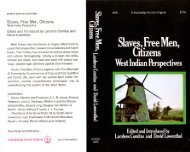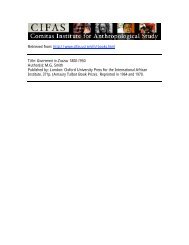You also want an ePaper? Increase the reach of your titles
YUMPU automatically turns print PDFs into web optimized ePapers that Google loves.
<strong>Kano</strong> Chron£cle 33<br />
II<br />
Besides Arabic manuscripts of the <strong>Chronicle</strong>, we have the two translations<br />
by Palmer and East into English and Hausa respecitvely. The Arabic texts<br />
translated by Palmer and East differ very little in organization and context,<br />
but mainly in spelling and one or two marginal notes. For example, while<br />
Palmer's text contains a note linking Bagauda to Bayajidda as the latter's<br />
grandson, East's does not. I2 Likewise, East's translation lacks Palmer's<br />
footnote on the praise-names of the Madawaki, Gwoji and Kosa in Yaji's<br />
reign (1349-85A.D.), and another on the first Fulani Emir, Suleimanu<br />
(1807-19 A.D.)I 3<br />
Palmer contrasts the text he used, which was found at Sabon Gari near<br />
Katsina, with another which Lady Lugard says was found at <strong>Kano</strong>,! 4 claiming<br />
that the latter manuscript was "not complete, since only 42 kings are<br />
mentioned" while that found at Katsina "goes down to, and breaks off in,<br />
the time of Mohammed Bello, the 48th king."1 5 East, using a text owned by<br />
Zubairu, the son of Sarkin <strong>Kano</strong> Dabo (1819~1846 A.D.) and grand-uncle of<br />
the late Emir Abdullahi Bayero, who loaned it to him, notes that that text<br />
was written (rubuta) in the reign of the Fulani Emir Muhammad. Bello<br />
(1883-1892), who had the <strong>Chronicle</strong> copied and extended up to his reign.I 6<br />
In like fashion in his Hausa translation East extended the <strong>Chronicle</strong> beyond<br />
the accession of Abdullahi Bayero (1926-1953). Evidently these successive<br />
extensions by Muhammad Bello and Rupert East illustrate the way in which<br />
the <strong>Chronicle</strong> may have grown, for until Muhammad Bello directed that it<br />
should be brought up to date, the text had ceased with the reign of Muhammad<br />
Alwali, the 43rd and last Hausa chief listed in the manuscript which<br />
Bello extended. Thus the text t,o which Lady Lugard refers ceased with<br />
Muhammad ·Alwali but omits one of the reigns recorded in Palmer's text.<br />
Writing around 1867, the Alkalin <strong>Kano</strong> Muhammadu Zangi comments<br />
briefly on a copy of the <strong>Chronicle</strong> which he had studied, which did not then<br />
extend Alwali's reign.! 7 In short, besides, copyists' errors, Arabic texts of<br />
the <strong>Kano</strong> <strong>Chronicle</strong> may differ in marginalia, in the number of Hausa chiefs<br />
they record, to a limited degree in their contents, and in their extension<br />
beyond 1807. It is tempting. to project this scholastic pattern of growth<br />
backwards into the past and to assume that the <strong>Chronicle</strong> was brought up<br />
to date at irregular intervals from time to time, particularly when the reigning<br />
chief so wished.<br />
In a note on the only three Arabic texts of the <strong>Chronicle</strong> that he could<br />
[md, Mervyn Hiskett remarks that all three were traced to a single <strong>Kano</strong><br />
mallam whose father, "Idris, was tutor to the royal family of Kana.,,18<br />
East's report that the Emir Abdullahi Bayero instructed his grand-uncle,<br />
Zubairu, the son of Ibrahim Dabo, to lend East his copy of the <strong>Chronicle</strong>,<br />
confirms the known scarcity of copies of the Arabic text.! 9 When Hiskett





